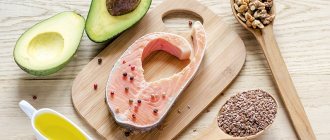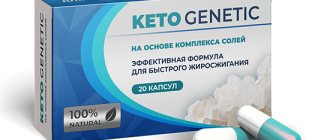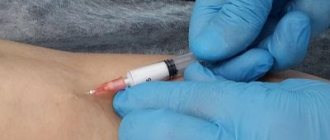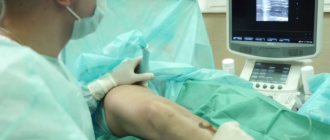In order for blood circulation in our body to function normally, it is necessary to constantly monitor the condition of the walls of blood vessels. And carry out systematic measures to strengthen them. If you provide assistance to your blood vessels in a timely manner, you can avoid serious diseases such as varicose veins, thrombosis, thrombophlebitis, and others.
One of the frequent questions from patients at our vascular center in Moscow is: “When should you pay attention to your blood vessels and prevent varicose veins on your legs?”
We have already talked about the causes of varicose veins on the legs in the article “I say NO to varicose veins.” Let's take a closer look at what symptoms may arise at the initial stage during weakening of the vascular wall.
The first 7 symptoms of varicose veins on the legs that are not taken seriously
When mentioning varicose veins, many patients imagine the disease like this: bulging veins, dark spots on the legs and a feeling of pain. However, these are symptoms of advanced development of the disease, and the patient ignores the first signs of varicose veins.
The first symptoms of varicose veins:
- Short-term dizziness;
- Cooling of extremities;
- Numbness of the legs;
- Mild pain;
- Distracted attention;
- Difficulty in the functioning of the speech apparatus;
- Change in skin color on the legs.
The appearance of at least one of these symptoms indicates that the vessels need support. To prevent the progression of varicose veins on the legs, you should reconsider your diet and lifestyle. Any favorable changes can significantly reduce the risk of developing the disease.
Silicon for increased elasticity
Silicon is an essential macroelement involved in the formation of connective tissues and epithelium. Its deficiency leads to a decrease in arterial elasticity and the development of many cardiovascular diseases.
To replenish silicon reserves, it is recommended to eat:
- Animal products. Chicken eggs, milk, caviar.
- Cereals. Brown rice, oats, barley.
- Beverages. Natural beer, red wine in moderation, and mineral water.
- Vegetables. Potatoes, beets, carrots, pumpkin, radishes, onions, eggplants.
- Fruits. Pineapples, apples, plums, peaches, grapes, apricots.
- Dried fruits. Raisins, dried apricots, prunes.
- Berries. Sea buckthorn, rowan, blueberry, black currant, cherry, sweet cherry.
- Nuts. Hazelnuts, almonds, cashews.
To restore silicon deficiency, it is recommended to use specially prepared water. You can do it at home without extra costs. To do this, small pieces of pure silicon are placed in a jar of drinking water.
Then the container is covered with a clean piece of gauze and placed in a bright place, but without access to direct sunlight. After a week of infusion, colloids are formed in the water, which can improve the microflora, rid the liquid of heavy salts and pesticides, and minimize the risk of bacterial infection.
The water obtained in this way must be carefully poured into another jar. The sediment, saturated with harmful substances, should be poured out. You can consume silicon water without restrictions, but before doing so, it is recommended to consult a doctor to prevent the occurrence of undesirable consequences.
Habits that damage blood vessels in your legs every day
Some habits have a detrimental effect on health and, first of all, this concerns blood vessels. The structure of blood vessels can be disrupted by:
- Insufficient physical activity. As you know, life is movement. A person needs to constantly move to keep the blood vessels in good shape. You should not stay in one position for a long time; change the position of your legs every 20 minutes. And don’t forget to do simple exercises in the morning and evening; it won’t take much time, but it will be a good prevention of varicose veins on the legs.
- Excessive loads. A person needs to move, but you shouldn’t overexert your body. Due to intense training and exercise in the gym, work in the country, heavy lifting and other loads, pressure in the vessels of the lower extremities increases significantly, which leads to stretching of the muscle fiber and the development of valvular insufficiency.
- Smoking has a negative effect not only on the respiratory system, but also on the blood vessels of the entire body. Toxic tobacco tars, entering the blood, destroy the walls of blood vessels and reduce their elasticity.
- Wrong wardrobe. Fashionable jeans that are tight around the legs and pelvis, socks with a tight elastic band, and tight, tight shoes disrupt the normal blood flow in the lower extremities, thereby causing swelling and blood stagnation.
- Overheating of the body. High temperatures cause the vessels to expand to their limits. Frequent and/or long periods of time in a bathhouse, under the scorching sun or on the beach also contribute to the dilation of blood vessels, which reduces their elasticity. And these are the first prerequisites for the development of varicose veins on the legs.
- Abuse of massage and anti-cellulite procedures. Too frequent active, lymphatic drainage and anti-cellulite massages and wraps also affect the condition of the walls of blood vessels. Before carrying out even health-improving cosmetic procedures, it is necessary to consult with a therapist or specialist at a treatment center.
The first signs of varicose veins on the legs are abundant purple or deep red bruises, large bruises. If you notice bruising for no apparent reason, consult a doctor immediately.
General principles of therapeutic nutrition
Before finding out what helps strengthen the circulatory system, it is important to understand the general principles of a diet that is beneficial for the circulatory system.
So, the Cardiology Association recommends:
- Eat often, every 2.5-3 hours. Portions should be small. Remember that complete satiety occurs 20-25 minutes after eating, so get up from the table with a slight feeling of hunger.
- Have dinner 3-4 hours before bedtime . The notorious mark on the clock at 18.00 is only an average indicator. So, if you go to bed at twelve at night, a light dinner should be no later than 20.00.
- Don't neglect breakfast. The morning meal is very important: it gives you a boost of energy for the whole day. Having a hearty breakfast will help your body wake up faster and help your arteries distribute blood throughout the body more actively.
- Drink enough fluids. The average norm for an adult is 1.5-2 liters of clean, unboiled water daily.
- Don't eat on the go. Make the eating procedure a kind of ritual. Use nice crockery and cutlery, chew each bite slowly, and enjoy your meal.
- Calculate your recommended daily calorie intake. This takes into account not only the height, weight, gender and age of the subject, but also the level of physical activity during the day.
- Try to eat less salt and sugar. Salt retains excess fluid in the body, which is fraught with the development of edema and chronic cardiovascular diseases. And excess sugar in the body causes disturbances in carbohydrate metabolism and is stored in extra pounds.
- The preferred cooking methods are steaming and baking. You will have to say goodbye to fried, smoked, pickled dishes.
This diet will not only strengthen the cardiovascular system, but will also help you lose extra pounds.
Note! The recommendations above are only valid for relatively healthy people. When drawing up a nutritional schedule for people with chronic diseases in the stage of decompensation, it is important to take into account some nuances, in particular the features of the drinking regime, the norms of salt, sugar consumption, etc.
What foods should you eat to strengthen the walls of blood vessels?
The main role in the healthy functioning of blood vessels and the entire body is played by properly selected nutrition. In order to strengthen blood vessels, it is necessary to eat:
- Vegetables and herbs are irreplaceable products that should be present in every meal. All plant foods contain large amounts of vitamin C and potassium - these are 2 important components that affect the health of the veins.
- Legumes. They contain components that prevent the deposition of cholesterol on the walls of blood vessels. In addition, they improve the elasticity of blood vessels.
- Decoctions of herbs and berries. They have a positive effect on the entire venous system thanks to antioxidants. Replace coffee with rosehip infusion and you will feel an improvement in the functioning of your entire body.
- Milk and dairy products. Due to their composition, cheeses and milk are easily absorbed by the body and do not overload it.
- Fish and seafood. Their daily consumption is an excellent prevention of vascular disease.
- Bitter chocolate. It has a positive effect on blood vessels throughout the body and reduces the risk of cholesterol plaques. Only chocolate should not contain sugar.
Remember that to strengthen the walls of blood vessels, it is not enough to change just your diet. You need to choose a gymnastic set of exercises for yourself and perform them regularly, give up bad habits and reduce the activity of cosmetic procedures. For patients suffering from congenital vascular problems, more drastic measures are required using medications and wearing compression garments.
How to get rid of cerebral vascular spasms
Poor circulation and vascular dystonia are the reasons why cerebral vascular spasms occur. The clinical manifestations of spastic attacks are familiar to many. This
- Regularly occurring headaches, dizziness, changes in blood pressure;
- Nausea, disturbances in speech and coordination of movements;
- Tinnitus, memory impairment;
- Fatigue and a sharp decrease in performance.
Vasospasm can be triggered by a stressful situation, changes in atmospheric pressure, or chronic diseases of the spine (osteochondrosis, for example). To minimize the risk of spasms, it is necessary to strengthen the blood vessels of the brain. This will be helped by a healthy diet, adherence to a work and rest schedule, medicinal herbs and special exercises.
To improve blood supply to the brain, daily gymnastics should include movements that require changing the position of the head - bending from side to side, rotating the head, flips and somersaults. When performing exercises, you must monitor your breathing and perform head movements smoothly, without jerking. If unpleasant sensations, darkening in the eyes, or severe dizziness occur, gymnastics should be interrupted and resumed after a short rest, reducing the intensity of movements.
A set of exercises to improve blood flow in the brain
- Performed standing, feet shoulder-width apart. Rotate your head clockwise and back for 2-3 minutes.
- I.P. - Same. Raise your hands up, interlace your fingers. Lean forward while performing “chopping wood” movements. Repeat 8 times.
- I.P. - Same. Swing your legs alternately: the left leg goes to the right hand, the right leg goes to the left hand.
- I.P. - the same, knees slightly bent. Stretch your arms to the sides and perform asynchronous rotations: rotate your left hand forward, your right hand back. Exercise improves memory and speed of thinking.
- I.P. – lying on your back, legs and arms extended along the body. Raise your legs straight as high as possible, supporting your lower back with your hands. Perform the “Birch” stand for up to 5 minutes.
Excellent gymnastics for the blood vessels of the brain is dancing. By performing dance steps, a person trains coordination, the blood is enriched with oxygen, and its circulation improves. Brain vessels become more elastic, their tone decreases. In addition, dancing is a great way to relieve emotional tension and get rid of stress. And this is a very significant factor in the improvement of brain vessels.
Video: a simple exercise to strengthen weak blood vessels
Get advice on strengthening the walls of blood vessels and sign up for diagnostics
Prevention and treatment of varicose veins should be carried out only under the supervision of a therapist and phlebologist. You can make an appointment with a doctor at the Vascular Center named after N.I. Pirogov in Moscow by phone +7 (499) 464-03-03. He will examine the lower extremities and, if necessary, prepare an individual treatment program.
Make an appointment with a phlebologist at the Vascular Center named after N.I. Pirogov in Moscow. We will put together a set of medications for you to prevent varicose veins.
Back to articles
Medicinal solution to the problem
When diagnosing disorders of the coronary, cerebral and peripheral circulation, complex therapy is indicated. Within its framework, medications from various drug groups are prescribed.
These include:
- Complex vitamin and mineral preparations (Panangin, Asparkam, Ascorutin, Lecithin, Beta-carotene).
- Nootropic drugs (Piracetam, Nootropil, Aminalon).
- Drugs with pronounced angioprotective properties (Detralex, Aescusan, Venarus).
- Antioxidant agents (Actovegin, Semax).
- Drugs that prevent the development of thrombosis (Curantil, Aspirin).
- Medicines to improve blood microcirculation (Trimetazidine, Cerebrolysin).
Taking medications as prescribed by the attending physician helps restore the elasticity of the vascular walls of the brain, improving intellectual abilities, inhibiting the onset of senile sclerosis, reducing the rate of blockage of arteries with blood clots, and preventing early heart attacks and strokes.
Diet Basics
Adjusting the usual menu will help to establish an uninterrupted supply of microelements necessary for the body. Nutrition in the autumn-winter period is of great importance for health for patients who are professionally involved in sports, heavy physical labor or people of retirement age.
Replenishing the deficiency of nutrients is possible with the help of:
- apples, pomegranates, grapefruits, lemons, tangerines, oranges;
- meat products and offal;
- various cereals;
- oily sea fish;
- legumes;
- pumpkin and sunflower seeds;
- vegetables, eggs;
- vegetable oils;
- dairy and fermented milk products;
- dark chocolate.
Separately, experts recommend using flaxseed oil. The product helps prevent blood clots, reduces blood density, and improves cholesterol levels. For heart disease, it must be used daily.
Excess weight is the first enemy of the heart and blood vessels. Constant increased load leads to rapid wear of tissues, and fortification only partially solves the problem. Obese patients need to reconsider their diet and switch to a diet with the mandatory inclusion of the above products in the menu.











